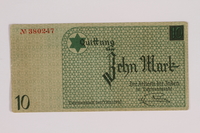Overview
- Description
- The Ariel S. Cardoso papers include identification papers, military papers, and photographs documenting
Cardoso’s postwar emigration to Palestine and his military service in the Jewish Brigade. Identification papers include a displaced persons identification certificate, an Israel Labor Federation membership booklet, an Israeli identification card and passport, a driver’s license, a medical insurance booklet, and Israeli ration cards. Military papers include a copy of Cardoso’s attestation upon joining the Palestine regiment, his service and pay book, and his discharge book. Photographs depict Cardoso with members of the Jewish Brigade including Manus Zarvanitzer and someone named Josi in Tel Aviv in December 1944 and in and Antwerp in May 1946. - Date
-
inclusive:
1944-1957
- Credit Line
- United States Holocaust Memorial Museum Collection, Gift of Ariel Cardoso. In memory of the unidentified Partisan who furnished my family and me with false identity documents but did not himself survive. He was later shot while trying to escape capture during a Nazi raid on his headquarters.
- Collection Creator
- Ariel S. Cardoso
- Biography
-
Ariel S. Cardoso (1918‐2013) was born Sigfrido Cardoso in Florence, Italy to Jewish parents who later moved to Rome. Following the German invasion of Italy in late 1943, the family was protected by their Christian neighbors in Rome who did not report them to the Nazis. Cardoso occasionally wore a Rome municipal military armband to conceal his identity. After Rome’s liberation, he worked for the British Eighth Army, received military training at a small kibbutz near Brindisi, and immigrated to Palestine. He joined the Jewish Brigade and served with the Palestine Regiment and Royal Army Service Corps in Italy, the Netherlands, Belgium, and France. After the war, as part of the 178 Transport Company of the Jewish Brigade, he helped smuggle Jewish refugees into Palestine. Back in Palestine, he served as an ambulance driver and medical aide during Israel's War of Independence. He started working at the U.S. Embassy in Tel Aviv in 1952 and met his future wife, Mary Randall. When Mary was transferred to Rome in 1955, he followed her and worked at the U.N. Food and Agriculture Organization. The couple was married in 1960, Cardoso became a U.S. citizen the following year, and the couple worked in the Foreign Service in Nigeria, Zanzibar, Indonesia, Lesotho, Gambia, Hungary, and German Democratic Republic before settling in Washington, DC.
Physical Details
- Genre/Form
- Photographs.
- Extent
-
4 folders
- System of Arrangement
- The Ariel Cardoso papers are arranged as a single series: I. Ariel S. Cardoso papers, 1944-1957
Rights & Restrictions
- Conditions on Access
- There are no known restrictions on access to this material.
- Conditions on Use
- Material(s) in this collection may be protected by copyright and/or related rights. You do not require further permission from the Museum to use this material. The user is solely responsible for making a determination as to if and how the material may be used.
Keywords & Subjects
- Topical Term
- Jews--Italy--Florence. Jewish refugees--Palestine.
- Geographic Name
- Palestine--Emigration and immigration. Israel.
Administrative Notes
- Holder of Originals
-
United States Holocaust Memorial Museum
- Legal Status
- Permanent Collection
- Provenance
- Ariel S. Cardoso donated the Ariel S. Cardoso papers to the United States Holocaust Memorial Museum in 1991.
- Funding Note
- The cataloging of this collection has been supported by a grant from the Conference on Jewish Material Claims Against Germany.
- Record last modified:
- 2023-08-25 08:43:29
- This page:
- https://collections.ushmm.org/search/catalog/irn608010
Additional Resources
Download & Licensing
In-Person Research
- Available for Research
- Plan a Research Visit
-
Request in Shapell Center Reading Room
Bowie, MD
Contact Us
Also in Ariel S. Cardoso collection
The Ariel S. Cardoso collection includes an Italian Labor Service armband, a Łódź ghetto scrip ten mark note, and identification papers, military papers, and photographs documenting Cardoso’s wartime hiding in Rome, postwar emigration to Palestine, and military service in the Jewish Brigade.
Date: 1944-1957

Łódź (Litzmannstadt) ghetto scrip, 10 mark note
Object
10 (zehn) mark receipt issued in the Łódź ghetto in Poland in May 1940. Nazi Germany occupied Poland on September 1, 1939; Łódź was renamed Litzmannstadt and annexed to the German Reich. In February, the Germans forcibly relocated the large Jewish population into a sealed ghetto. All currency was confiscated in exchange for Quittungen [receipts] that could be exchanged only in the ghetto. The scrip was designed by the Judenrat [Jewish Council] and includes traditional Jewish symbols. The Germans closed the ghetto in the summer of 1944 by deporting the residents to concentration camps or killing centers.




